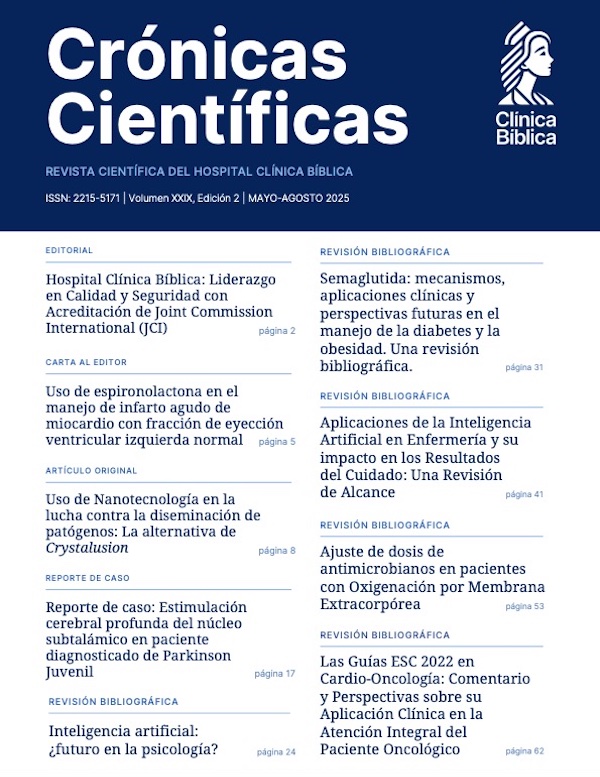- Visto: 967
Revisión Bibliográfica
Colangitis esclerosante primaria
Primary sclerosing cholangitis
DOI: https://doi.org/10.55139/DLGZ1699
APA (7ª edición)
Cárdenas-Quirós, F., Rojas-Chaves, S., Álvarez-Chaves, R. (2018). Colangitis esclerosante primaria. Crónicas Científicas, 9(9), 26-32. https://doi.org/10.55139/DLGZ1699.
Vancouver
Cárdenas-Quirós, F., Rojas-Chaves, S., & Álvarez-Chaves, R., Colangitis esclerosante primaria. Cron Cient, 30 de marzo 2018; 9(9): 26-32.
Dra. Fabiola Cárdenas Quirós
Médico General. Emergencias Médicas Monteverde. San José, Costa Rica.
Miembro del Colegio de Médicos y Cirujanos de Costa Rica.
Costa Rica.
Dr. Sebastián Rojas Chaves
Médico General. Clínica Dr. Marcial Fallas Díaz. San José, Costa Rica.
Miembro del Colegio de Médicos y Cirujanos de Costa Rica.
Costa Rica.
Dr. Ricardo Álvarez Chaves
Cirujano General. Hospital San Juan de Dios. San José, Costa Rica.
Miembro del Colegio de Médicos y Cirujanos de Costa Rica.
Costa Rica.
Resumen
La colangitis esclerosante primaria (CEP), según estudios realizados fue descrita por primera vez por Delbet en 1924 como una enfermedad hepática crónica caracterizada por presentar fibrosis e inflamación de los conductos biliares intrahepáticos y extrahepáticos (Feldman, Friedman y Heisenger, 2002). La etiopatogenia es desconocida pero se ha visto interacción multifactorial en ella; entre los trastornos de la inmunidad, agentes tóxicos o infecciosos intestinales, deterioro isquémico de los conductos biliares y posiblemente una variación en los transportadores hepatobiliares. En su epidemiología, caracteriza mayor frecuencia de aparición en hombres que en mujeres, con una media de edad de 40 años. Clínicamente puede ser asintomática o con afección de las vías biliares intrahepáticas o asociada a hepatitis autoinmunitaria, en la mayoría de los casos se asocia con colitis y presenta un proceso colestásico crónico que finalmente conduce a una cirrosis biliar. Bioquímicamente muestra una analítica de colestasis, pero se considera de mayor utilidad diagnóstica el uso de la colangiografía retrógrada endoscópica (CPRE) o de la colangiorresonancia (CPRM) como el primer procedimiento ya que es igualmente informativa y no invasiva, mientras que la biopsia hepática no es esencial para el diagnóstico. Respecto al tratamiento de la enfermedad, no existe un fármaco curativo y, a pesar de los intentos con el uso del ácido ursodesoxicólico, solo ha demostrado mejoría en las alteraciones bioquímicas de colestasis, acompañado de un panorama internacional muy controvertido acerca de su utilidad, dejando al trasplante hepático como último recurso terapéutico con buenas expectativas de supervivencia, aunque con una probabilidad de recidiva de la enfermedad en el hígado trasplantado.
Palabras claves
Colangitis, esclerosante, primaria, colangiocitos, CPRE, CPRM, CEP.
Abstract
Primary sclerosing cholangitis (PSC), according to studies was first described by Delbet in 1924, as a chronic liver disease characterized by fibrosis and inflammation of the intrahepatic and extrahepatic bile ducts (Feldman, Friedman & Sleisenger, 2002). The etiopathogenesis is unknown but it has seen multifactorial interaction in it; among the immunity disorders, intestinal toxic or infectious agents, ischemic deterioration of the bile ducts and possibly a variation in the hepatobiliary transporters. In its epidemiology it characterizes a higher frequency of appearance in men than in women, with an average age of 40 years. Clinically it can be asymptomatic or with intrahepatic bile duct disease or associated with autoimmune hepatitis, in most cases it is associated with colitis and presents a chronic cholestatic process that finally leads to biliary cirrhosis.
Biochemically it shows an analytic of cholestasis, but it does consider the diagnostic utility the use of endoscopic retrograde cholangiography or cholangioresonance as the first procedure that is equally informative and non-invasive, while liver biopsy is not essential for diagnosis. Regarding the treatment of the disease, there is no curative drug, and despite the attempts with the use of ursodeoxycholic acid it has only been shown to be better in the biochemical alterations of cholestasis, accompanying a very controversial international panorama about its usefulness, leaving the liver transplantation as a last therapeutic resource with good survival expectations, although with a probability of recurrence of the disease in the transplanted liver.
Keywords
Cholangitis, Sclerosing, Primary, Cholangiocytes, ERCP, MRCP, PSC.
Bibliografía
1. Acosta, J.C., et al. (2008). Chemokine signaling via the CXCR2 receptor reinforces senescence. Cell, 133, 1006-1018.
2. Angulo, P., et al. (2000). Magnetic resonance cholangiography in patients with biliary disease: Its role in primary sclerosing cholangitis. Journal of Hepatology, 33, 520-527.
3. Angulo, P. & Lindor, K.D. (1999). Primary sclerosing cholangitis. Hepatology, 30, 325-332.
4. Berstad, A.E., et al. (2006). Diagnostic accuracy of magnetic resonance and endoscopic retrograde cholangiography in primary sclerosing cholangitis. Clinical Gastroenterology and Hepatology Journal, 4, 514-520.
5. Boonstra, K., Beuers, U. & Ponsioen, C.Y. (2012). Epidemiology of primary sclerosing cholangitis and primary biliary cirrhosis: a systematic review. Journal of Hepatology, 56, 1183.
6. Brandsaeter, B., et al. (2003). Liver trasplantación for primary sclerosing cholangitis in the Nordic countries: Outcome after acceptance to the waiting list. Liver Transplantation, 9, 961- 969.
7. Chapman, R., et al. (2010). Diagnosis and management of primary sclerosing cholangitis. Hepatology, 51, 660-678.
8. Coppe, J.P., et al. (2008). Senescence associated secretory phenotypes reveal cellnonautonomous functions of oncogenic RAS and the p53 tumor suppressor. PLOS Biology, 6, 2853-2868.
9. Eaton, J.E., Talwalkar, J.A., Lazaridis, K.N., Gores, G.J. & Lindor, K.D. (2013). Pathogenesis of primary sclerosing cholangitis and advances in diagnosis and management. Gastroenterology, 145: 521-536.
10. Feldman, M., Friedman, L., & Sleisenger, M., Sleisenger & Fordtran’s Gastrointestinal and Liver Disease. (2002). 7th Ed. Elsevier, 1131-1144.
11. Fiorucci, S., et al. (2005). A farnesoid X receptorsmall heterodimer partner regulatory cascade modulates tissue metalloproteinase inhibitor1 and matrix metalloprotease expression in hepatic stellate cells and promotes resolution of liver fibrosis. Journal of Pharmacology and Experimental Therapeutics, 314, 584-595.
12. Fosby, B., Karlsen, T.H., & Melum, E. (2012). Recurrence and rejection in liver transplantation for primary sclerosing cholangitis. World Journal of Gastroenterology, 18, 115.
13. Hirschfield, G.M., Karlsen, T.H., Lindor, K.D. & Adams, D.H. (2013). Primary sclerosing cholangitis. Lancet, 382, 1587-1599
14. Jussila, A., Virta, L.J., Pukkala, E. & Färkkilä, M.A. (2013). Malignancies in patients with inflammatory bowel disease: a nationwide register study in Finland. Scandinavian Journal Gastroenterology, 48, 1405-1413.
15. Konstantinos, N., & Nicholas, F. (2016). Primary Sclerosing Cholangitis. The New England Journal of Medicine, 375, 1161-1170.
16. Kuilman, T., et al. (2008). Oncogeneinduced senescence relayed by an interleukindependent inflammatory network. Cell, 133, 1019-1031.
17. Lindor, K.D. (1997). Ursodiol for primary sclerosing cholangitis. The New England Journal of Medicine, 336, 691-698.
18. Lindor, K.D., et al. (2009). Highdose ursodeoxycholic acid for the treatment of primary sclerosing cholangitis. Hepatology, 50, 808-814.
19. Liu, J.Z., et al. (2013). Dense genotyping of immune-related disease regions identifies nine new risk loci for primary sclerosing cholangitis. Nature Genetics, 45, 670-675.
20. Mendes, F.D., et al. (2006). Elevated serum IgG4 concentration in patients with primary sclerosing cholangitis. American Journal of Gastroenterology, 101, 2070-2075.
21. Molodecky, N.A. et al. (2011). Incidence of primary sclerosing cholangitis: a systematic review and metaanalysis. Hepatology, 53, 1597.
22. Nakken, K.E., et al. (2007). Multiple inflammatory, tissue remodellingand fibrosis genes are differentially transcribed in the livers of Abcb4 (/) mice harbouring chronic cholangitis. Scandinavian Journal Gastroenterology, 42, 1245-1255.
23. O’Hara, S.P., et al. (2011). Cholangiocyte NRas protein mediates lipopolysaccharide induced interleukin 6 secretion and proliferation. The Journal of Biological Chemistry, 286, 30352-30360.
24. O’Hara, S.P., Tabibian, J.H., Splinter, P.L. & LaRusso, N.F. (2013). The dynamic biliary epithelia: molecules, pathways, and disease. Journal of Hepatology, 58, 575-582.
25. Parés, A. (2011). Colangitis esclerosante primaria: diagnóstico, pronóstico y tratamiento. Gastroenterología y Hepatología - Elsevier, 34, 41-52.
26. Stiehl, A. (2006). Primary sclerosing cholangitis: The role of endoscopic therapy. Seminars in Liver Disease, 26, 62- 68.
27. Tabibian, J.H., et al. (2013). Randomised clinical trial: vancomycin or metronidazole in patients with primary sclerosing cholangitis — a pilot study. Alimentary Pharmacology & Therapeutics, 37, 604-612.
28. Tabibian, J.H., O’Hara, S.P., Splinter, P.L., Trussoni, C.E., & LaRusso, N.F. (2014). Cholangiocyte senescence by way of Nras activation is a characteristic of primary sclerosing cholangitis. Hepatology, 59, 2263-2275.
29. Tchkonia, T., Zhu, Y., VanDeursen, J., Campisi, J., & Kirkland, J.L. (2013). Cellular senescence and the senescent secretory phenotype: therapeutic opportunities. The Journal of Clinical Investigation, 123, 966-972.
30. Trottier, J. et al. (2012). Metabolomic profiling of 17 bile acids in serum from patients with primary biliary cirrhosis and primary sclerosing cholangitis: a pilot study. Digestive and Liver Disease Journal – Elsevier, 44, 303-310.
31. Vikas, K. (2017). Primary Sclerosing Cholangitis. Medscape, 1-8.
APA (7ª edición)
Cárdenas-Quirós, F., Rojas-Chaves, S., Álvarez-Chaves, R. (2018). Colangitis esclerosante primaria. Crónicas Científicas, 9(9), 26-32. https://doi.org/10.55139/DLGZ1699.
Vancouver
Cárdenas-Quirós, F., Rojas-Chaves, S., & Álvarez-Chaves, R., Colangitis esclerosante primaria. Cron Cient, 30 de marzo 2018; 9(9): 26-32.
Esta obra está bajo una licencia internacional Creative Commons: Atribución-NoComercial-CompartirIgual 4.0 Internacional (CC BY-NC-SA 4.0)

Realizar búsqueda
Última Edición
Ediciones






